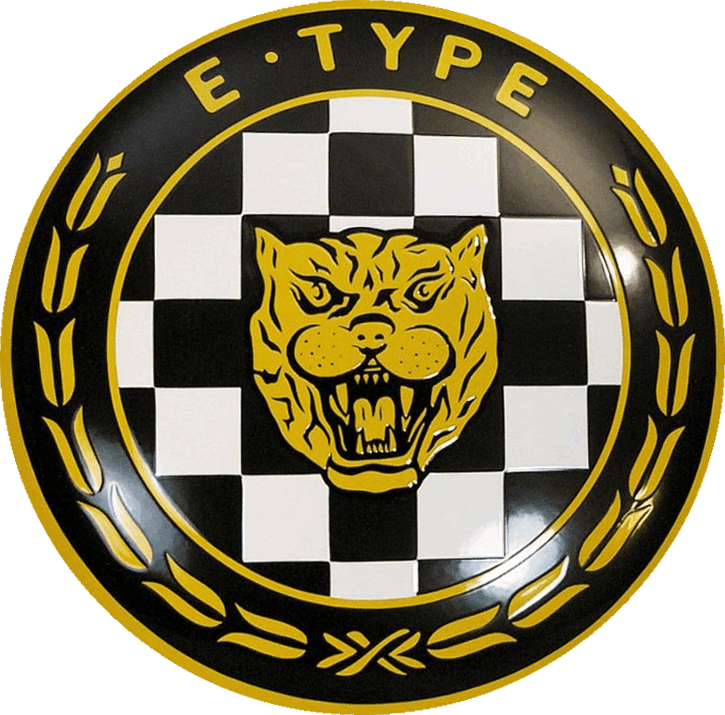
JAGUAR E-TYPE 60th ANNIVERSARY
Classic Showcase takes a look at the E-Type and its history in North America
In March of 1961, Jaguar introduced a new sports car to the European automotive world known as the E-Type, a car that has by any reasonable measure become one of the most fashionable collector cars of all time. This new model was unveiled at the Geneva Motor Show in Switzerland, where attendants were awestruck by its sheer beauty, elegant design, and performance options. The E-Type’s design was a blend of aircraft engineer and automotive aerodynamist Malcolm Mayer’s, complimented by one of Jaguar’s founders Sir William Lyons, culminating in a style that caused nothing short of pure sensation during its Swiss debut; the E-Type created such a stir in automotive circles that Enzo Ferrari himself described it as “The most beautiful car ever made.”
The E-Type was not only a beautifully designed vehicle, but a tremendous value as well, by offering previously unheard-of performance options from a vehicle half the cost of a Ferrari or Aston-Martin. In fact, the 6-cylinder 3.8-liter engine was capable of reaching speeds up to 150 mph, that eclipsed what other esteemed sports cars couldn’t achieve at a much lower price. This sensational new sports car was indeed taking the world by storm, and it was only a matter of time before it would travel across the pond to conquer the North American market; and less than a month after its breathtaking debut In Geneva, the E-Type did just that, with its American debut at the 9-day International Automobile Show in New York City.
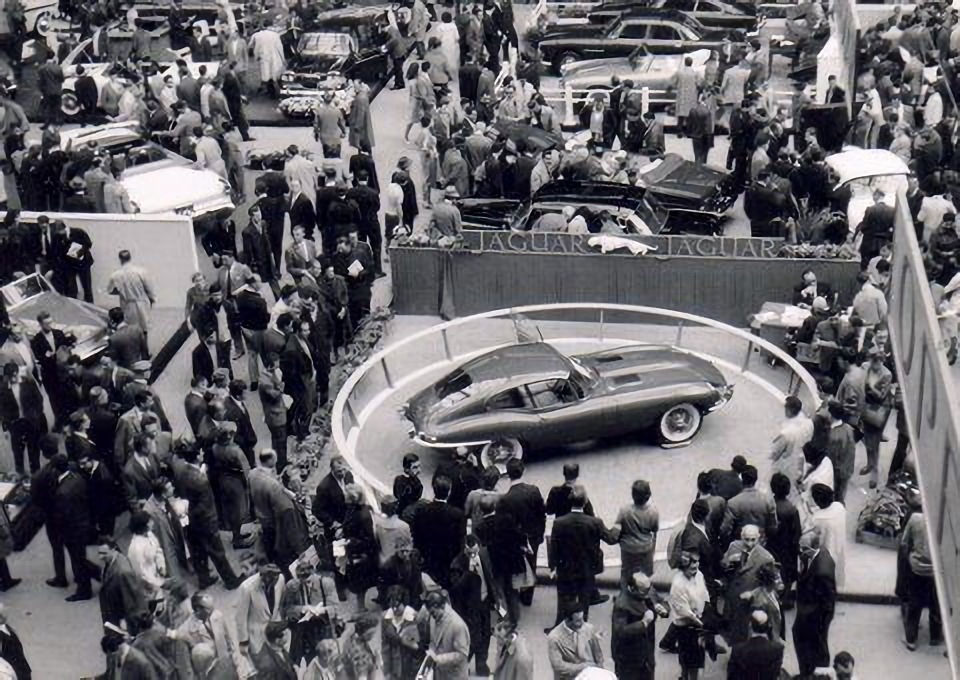
As with the debut in Geneva, the E-Type’s reception in the states was nothing short of extraordinary. Not only did it become the focal point of the show, but it attracted record-breaking crowds with over 300,000 attendants setting their first sights on this amazing new sports car. The opalescent Bronze Coupe was displayed on a raised turntable placed above the crowd, with then Playboy centerfold Marilyn Hanold, dressed in a shimmering gown, long white gloves, and a floor-length silk scarf, providing an added boost of elegance and class to an already exciting display. With its faired-in headlamps, long sculpted nose and centered twin exhaust, the E-Type was ready to take America by storm. In fact, the XKE was so popular at its American debut, that during the first hour of the show, an average of 1 XKE was sold every hour of the show, resulting in nearly 15 million dollars in sales – in 1961!
While the E-Type was first noticed on the European continent, it really hit the mark in the United States, where the beginnings of the cultural revolution of the 60s were just taking hold. While American veterans returning home from WW2 were the first to show a renewed interest in British motoring, it was their children’s generation – the Baby Boomers - that saw the real beauty and performance in the affordable E-Type sports car.
As the 60s progressed, E-Type production in the United States exploded. By 1963, more than a third of all XKE production was occurring in the United States. In 1964, Jaguar produced the 4.2 liter to increase torque, and a fully synchronized gearbox to replace the early Moss crashbox, improved braking system, and an improved cooling system. In addition, more refinements were made for comfort to make this a popular touring car in America; these improvements included arm rests on the doors, adding a center console for storage, and bigger reclining bucket seats to name a few.
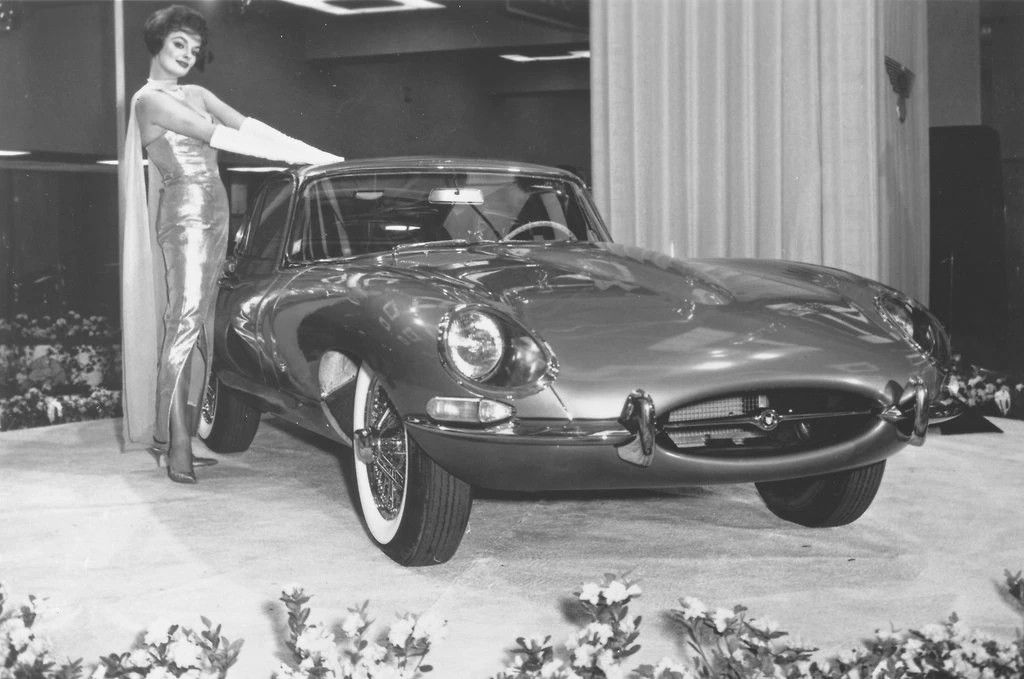
In 1966, Jaguar added a 2+2 XKE model aimed at the American market, with an optional automatic version available as well. This was an attractive model for the “family man” that wanted the performance and look of a sports car, but also being able to take his family along for the ride. The 2+2's length and wheelbase were extended nine inches, with a taller roofline. The reason for the new model design was that Americans wanted to take more than one passenger with them, and also have the ability to carry more cargo in their travels. In fact, the E-Type was such a success, that 80 percent of Jaguars production of the 2+2 model was earmarked for the U.S. market.
In 1968, Jaguar had to conform to U.S. standards, but sought to keep the same body design as the Series 1. Some of these changes had already been introduced in 1967 models for the British market, with remaining changes added early in 1968. These changes came about to address new safety and emission standards in the United States, and in turn produced an intermediate, yet unofficial entry in the E-Type series that most refer to as the “Series 1.5” E-Type. The exterior and interior changes included open headlights, new door mirrors, the elimination of ears on hubs, changing Toggle switches to Rocker switches, and the addition of Sundym glass and all-Red lenses on rear taillight clusters. Mechanically, carburetion was changed from the traditional (3) SU layout to a Twin Stromberg system with a manifold crossover for U.S. emissions, which slightly lowered horsepower but enabled the E-Type to meet stringent American emission standards. Other additions for 1968 included a single ignition/starter, improved door locks, emergency flashing light system, and a turn signal stalk with integrated horn button. In addition, the seat backs reclined, and headrests were added. Americans such as legendary musician Roy Orbison, as well as actor Tony Curtis were just some of the celebrities that proudly owned an E-Type of their own.
In October of 1968, Jaguar officially launched the Series 2 E-Type at Earl’s Court in London; the Series 2 grew in large part from many of the changes and improvements performed since the Series 1, and also incorporated the changes made during the Series “1.5” run – but was technically a 1969 model car. Great efforts were made by Jaguar to keep the E-Type original to the Series 1 while adhering to U.S. standards. Stateside, the Series 2 was unveiled at the same venue as the Series 1 in 1961 – the New York Motor Show, with (3) versions of the car on display – 2 Roadsters, a Fixed Head Coupe, and the 2+2. Unlike some of its competitors who in many cases abandoned exportation of their inventory to the States, Jaguar was proud of the fact that it was able to make accommodations to the E-type in order to be sold in the valuable U.S. market. The Series 2 line of E-Types addressed the American Federal Safety Council’s requirements, and incorporated other safety measures, indicative of Jaguar’s continued drive to refine and adapt the E-Type. In addition, the Series 2 provided a long-desired power steering option to the E-Type, which was a sought-after item that famed Jaguar test-driver Norman Dewis wanted in the original Series 1 XKE. The Series 2 was met with generally favorable reviews by its American audience, with magazines such as Car and Driver stating that the Series was one of the “finest upgrades of the E-Type yet”; and while some of the compromises made to the Series 2 resulted in diminished performance to that of its predecessors, it still possessed the beauty and sign of quality that started with the Series 1 line of cars. As the Series 2 entered the market, Jaguar was working behind the scenes to create its next and subsequently final iteration of the E-Type, a model that would stay true to the core Series 1 design, yet address the need to branch out from the older XK series power plant.
In the early 70s, American muscle cars were making a huge impact on car sales in America. In order for Jaguar to be competitive for the U.S. market, they needed to produce a model with an increase in horsepower, improved comfort, while simultaneously meeting U.S. regulations and keeping the E-Type’s traditional styling intact. The Series 3 was a much roomier version of the E-Type with a long wheelbase and reclining seats and improved the Air Conditioning system over the Series 2 models. The focal points of the Series 3 model were Jaguar’s new 5.3-liter V12 engine and power steering as an option. The Series 3 also featured a grille that filled the
E-Type's radiator opening, along with flared wheel arches to better accommodate larger sized tires – which is something the American market requested to have a larger footprint on the road to compete against American muscle cars. These changes resulted in the E-Type reaching a much broader spectrum of the American market, where some considered the Series 3 to have the smoothest driving experience of all E-Types produced. For the first time in the E-Type’s history, the Series 3 was debuted in the United States at the New York Motor Show, where Jaguar designers spoke of the new V12 powered XKE as a great performer ready for the U.S. market. The Series 3 was the final iteration of the E-Type, with main production ending in September of 1974. Jaguar wanted to continue E-Type production with a special commemorative model, and did just that with its final 50 cars produced; these cars were roadsters that were dressed in a black finish paying tribute to the ending of this very special car and era. In a span of 14 years, there were 72,507 E-Types produced.
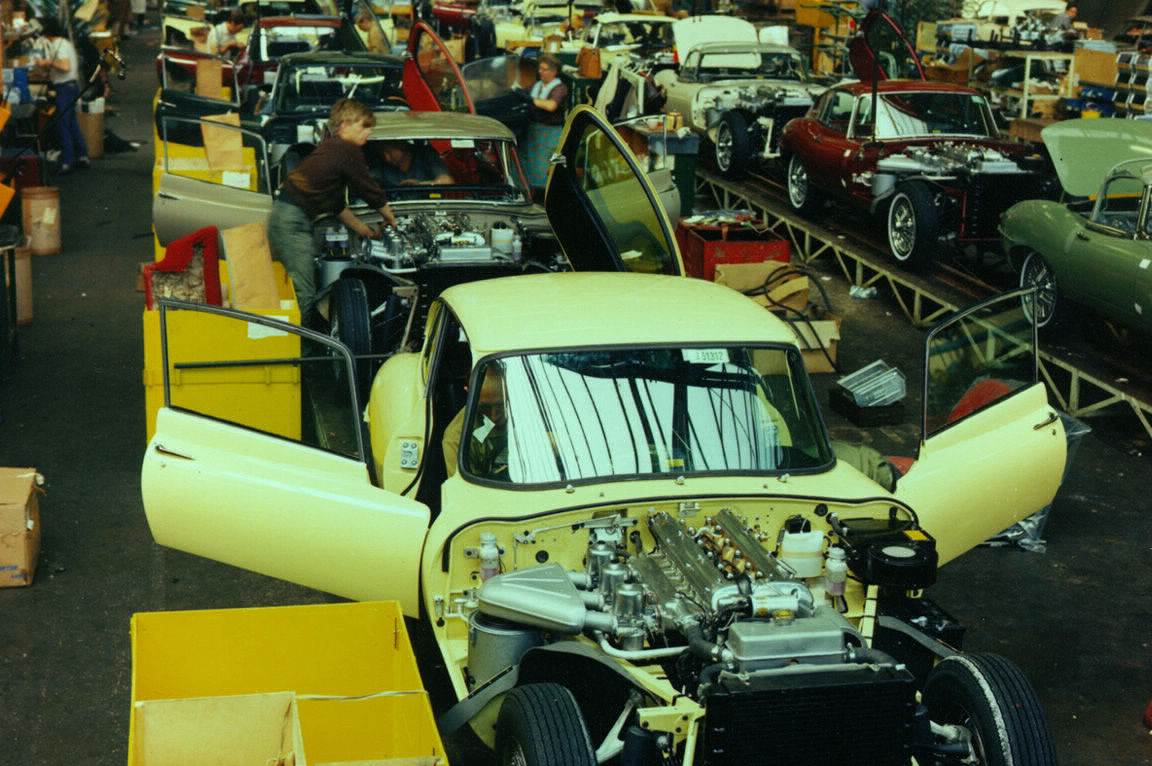
While the E-Type was famous all over the world, its impact on the American market was significant. To this day, the XKE has remained one of the most sought-after sports cars of the 60s and 70s in the United States classic car market, with no signs of its popularity slowing down. The E-Type has not only lived on, but it has thrived through the help of restorers around the country and organizations such as the Jaguar Clubs of North America (JCNA), who have not only kept the classic spirit alive, but have created clubs that organize events so owners of XKEs as well as other classic Jaguar models can share their renewed passions.
Jaguar Clubs of North America dates back to the 1950s, when U.S. service members had returned home from Europe, fascinated by British sports cars. Many of these service members had Jaguars shipped home, and as such the Jaguar Owners' Association was established in 1954. By 1958, Jaguar Cars thought there might be some mutual interests with enthusiasts in North America, so they offered to help with the organization and the Jaguar Clubs of North America was born. As of 2020, the JCNA consists of nearly 5,500 members in 63 clubs in North America, including the United States, Canada, and Mexico. The JCNA provides structure and direction to these local clubs, produces the Jaguar Journal magazine, and has an event called the International Jaguar Festival, where the E-Type is almost always the focus of the show. One of the biggest accomplishments of the JCNA, are the sanctioned Concours events held by individual clubs throughout the country. A rules committee was setup and has created guidelines for judging all Jaguar cars in (2) classes, with one called the Champion class, and the other the Driven class. In addition, the JCNA has created rule books that are updated yearly through its Annual General Meeting (also known as the AGM), where they vote on new rules and eliminate others. The general idea is to have all of the JCNA clubs judged equally. The JCNA also holds annual Judges Training Sessions for individual clubs to teach them the new rules that have been adopted and enforce the older rules already in place. The International Jaguar Festival has taken place most recently in Scottsdale, AZ (December 2016), Buford, Georgia (October 2017), and Santa Barbara, California (August 2018), with the E-Type consistently being the “star of the show” by all attendees.
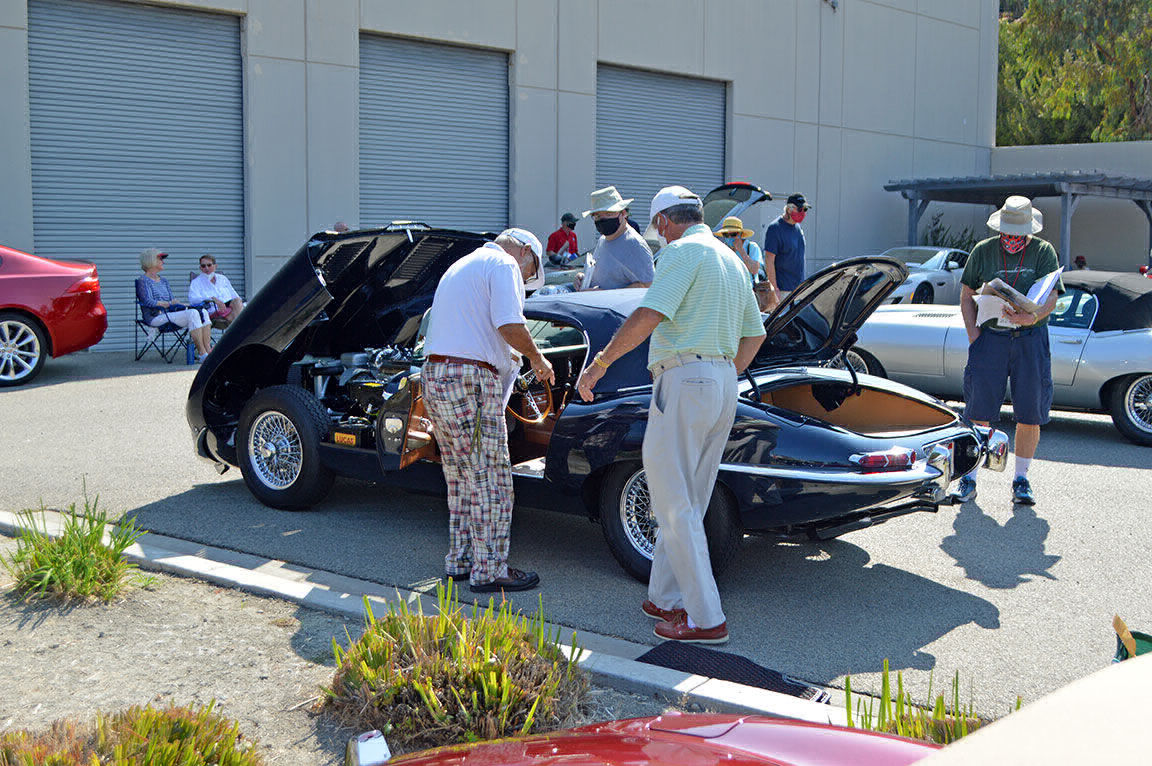
In 2011, the E-Type turned 50 years old, and witnessed a massive resurgence of popularity in the United States. Dozens of automotive publications, as well as the media at large had covered the anniversary, creating a huge buzz in automotive circles all over the country. It seemed that suddenly, collectors in America that had been previously focused on other marques like Ferraris and Mercedes were now desiring their own E-Type, yet one that was fully restored to high level. With that, many American restoration companies started embarking on a mission to purchase and restore E-Types to meet this new demand. The 50th anniversary celebration in 2011 had in fact catapulted the E-Type back into the limelight, carrying this newfound excitement over to the next 2 years - which saw the XKE go from a mere classic car to that of a classic car superstar. As restoration companies continued restoring and selling E-Types after the anniversary in 2011, collectors could sense that the E-Type was on the verge of taking the collector car market by storm; and in 2013, one auction event in New York City did just that, propelling the XKE to yet another famous milestone. The event was RM/Sotheby’s Art of the Automobile sale, where a triple-Black 1966 E-Type Roadster named “Black Beauty” restored by
Classic Showcase of Oceanside, California set a new world sales record when it sold for an astonishing buyer-paid premium of $467,000 USD. At the time, this fully restored roadster - chassis no. 1E11911 – was the most any production E-Type had sold for in the world, raising the bar on what collectors would pay for the best restored examples. Tom Krefetz of Classic Showcase claimed that the sale “was like nothing he had ever seen” in 30 years of restoring, marketing, and selling Jaguars. In addition to its exhaustive show-level restoration, the XKE also benefitted from its pedigree – where it was the recipient of (3) perfect scores in JCNA-sanctioned events. The car had also been chosen by Jaguar earlier in the year to be used in a timeline display of Jaguar cars alongside its new F-Type model at the Pebble Beach Concours d’Elegance, in Pebble Beach, CA. The news of the sale reverberated around the world, creating yet another layer of excitement amongst those in the restoration industry and Jaguar enthusiasts alike. The sale also resulted in a new era of refinement for the industry, as the demand for perfectly restored E-Types became standard among serious collectors looking for the best.
From the 50th anniversary to the present day, E-Types in America are as popular as they were when they first launched in 1961. There are E-Type owners who are focused on competition in Concours events striving for perfection with perfect scores, and there are those that simply want to drive and enjoy their cars on the open road. There are also those who like to use their E-Type in a competitive nature, taking part in vintage and slalom racing, as well as rally touring. In addition, there is a growing base of XKE owners that simply enjoy driving their cars on a regular basis on their favorite roads - instead of just letting them sit in their garage. I feel that there is no end to the E-Type’s excitement, enthusiasm and continued success; so much so, that Classic Showcase is booked with 3 years of restoration work commissioned on E-Types as further evidence of the car’s continued popularity in the United States; with the celebrations of the 60th anniversary of the E-Type in America on the horizon, there is sure to be a tremendous amount of new interest and excitement around the XKE, just as there was for the 50th anniversary. In over 30 years of being in the classic car industry, there has been no other car that has appealed to so many different generations of people, who recognize the beauty, performance and shear elegance that the E-Type possesses; it has proven to be much more than just a British sports car, but a work of art in itself that is sure to be celebrated for generations to come.